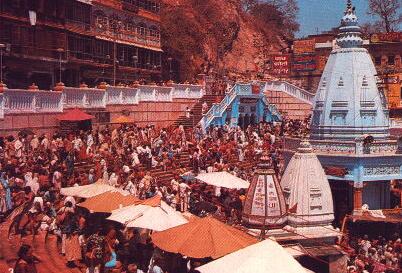Prayag is one of the ancient
pilgrimage centers of India, and it represents the confluence of the rivers Yamuna
and Ganga, near (in) the city of Allahabad in Uttar Pradesh. Prayag
is revered in the hymns of the Rig Veda. Tradition regards the
region between the Ganga and the Yamuna as the most fertile region on earth.
Prayag is referred to as Triveni Sangamam
- where it is believed that the subterranian river Saraswati also meets
the Ganga along with the Yamuna.

Legend has it that at the time of the
great deluge which submerges the earth at the end of each aeon, Prayag remains intact and
that Vishnu resides here as a Yoga Murthy, on a banyan leaf in the form
of a child. Vishnu is referred to as Veni Mahadeva, and Shiva is believed to be
personified here as the immortal banyan tree or the Akshaya Vata Vriksham.
(Alongside this tree is a shrine to Shiva).
Prayag is also associated with the legend of the celestial nectar of immortality - Amritam.
A variation of the legend has it that Jupiter, the guru of the Devas, picked up the pot of
the celestial nectar as it emerged from the milky ocean and made off with it, to prevent
the demons from having access to it. The enraged demons chased him. In the course of the
chase, the pot Kumbha overflowed, and the nectar fell into four different places on earth,
corresponding to Prayag, Nasik, Ujjain and Haridwar.
Offerings are made to the souls of the departed by
visiting pilgrims here, as in Benares and in Gaya.
Bathing at the confluence of the three rivers -
Triveni Sangam is considered special in the Hindu month of Magha - when the sun resides in
Capricorn - especially on Makara Sankranti, Ratha Saptami,
the full moon and new moon day.
Prayag is the seat of Kumbha Mela
celebrations once in twelve years when the planet Jupiter resides in the zodiac sign of
Taurus. Kumbha Mela is celebrated at Nasik, Ujjain and Haridwar.
when Jupiter resides in the signs of Leo, Scorpio and Aquarius.
See Also:
The churning of the Milky Ocean
Kumbhakonam - the temple town
